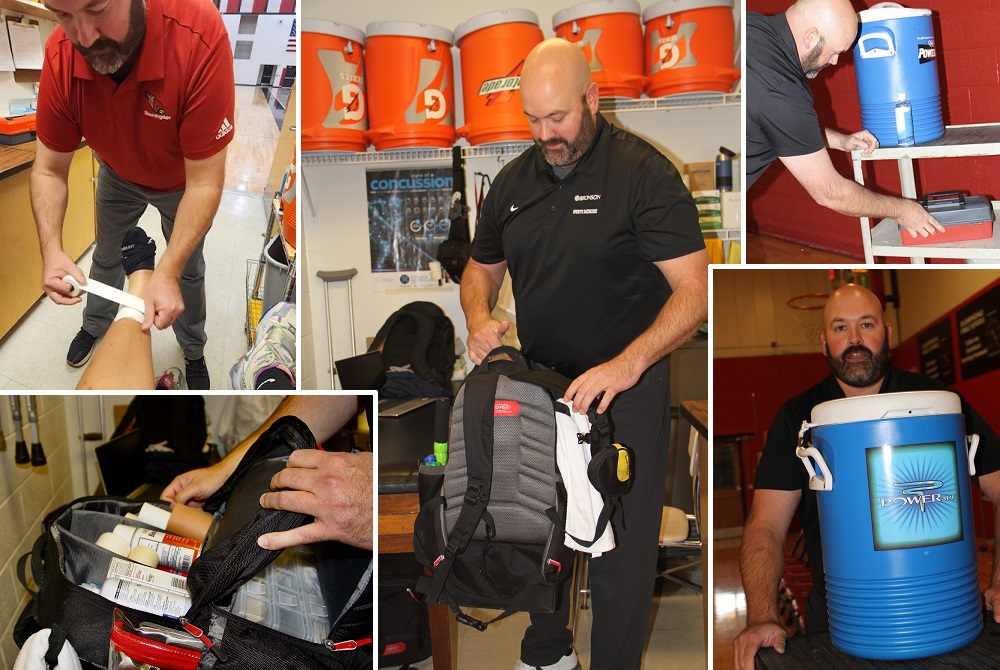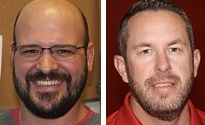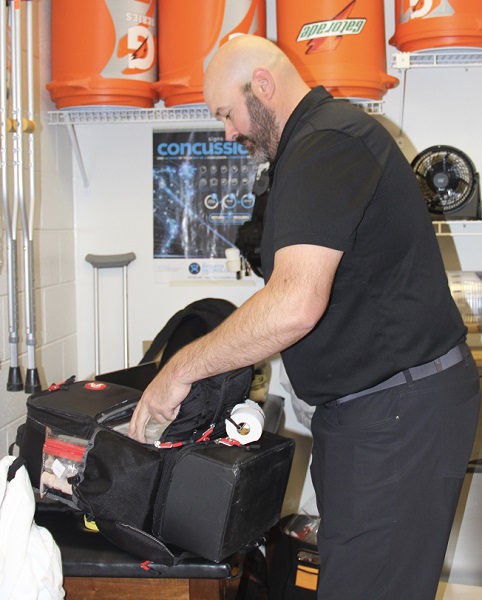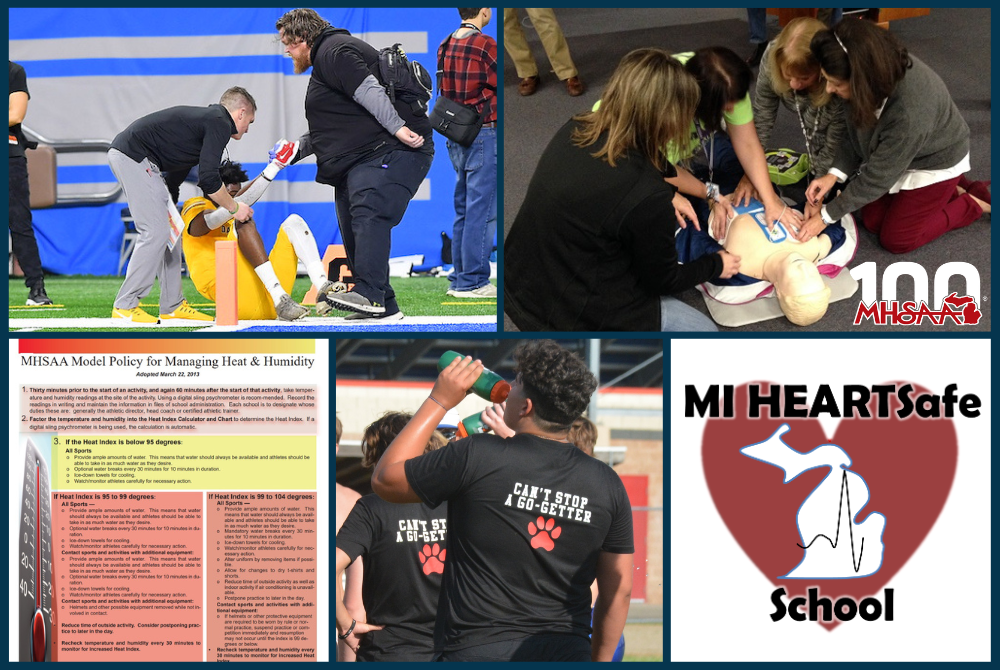
Bloomingdale Trainer Performing Invaluable Role in Keeping Athletes Playing
By
Pam Shebest
Special for MHSAA.com
November 22, 2022
BLOOMINGDALE — If Scott Allison looks bored during one of Bloomingdale’s sporting events, that is a good thing.
 “Trainers like to be behind the scenes and in the shadows,” the certified athletic trainer said. “We’re only needed in emergencies.
“Trainers like to be behind the scenes and in the shadows,” the certified athletic trainer said. “We’re only needed in emergencies.
“It’s one of those jobs that if we’re sitting around looking bored, then things are going well.”
But if an athlete goes down with an injury, Allison is quick to run onto the court or field.
In his first year at Bloomingdale, he has found that working with middle and high school students is a lot different than his previous work with the minor-league hockey Kalamazoo Wings.
Treating the hockey team, with whom he spent much of his 22 years, “There was a lot of traumatic stuff like lacerations or deep contusions, overuse injuries like hip flexors or core injuries or broken bones.
“Everything’s acute and fast. It’s a different animal. In hockey, they’re all pro athletes so they know their bodies really well.”
However, high school and middle school athletes are still in a growing phase.
“These kids don’t really know what’s going on a lot of times, so it’s a lot more education on what’s happening,” Allison said.
“Is it an injury, or is it just soreness? You get a lot of kids that don’t understand the difference between aches and pains or an injury. We see a lot of ankle sprains or shin splints because they’re just developing. They’re in that awkward range where their bodies try to grow too fast.”
 Allison is the Cardinals’ first certified athletic trainer, a new position for which athletic director Jason Hayes campaigned.
Allison is the Cardinals’ first certified athletic trainer, a new position for which athletic director Jason Hayes campaigned.
“What we notice is that if a kid’s injured, they’re out a lot less if you have a trainer because it speeds up recovery time,” said Hayes, who also coaches varsity football and is an assistant wrestling coach. “It’s like having a built-in physical therapist on your staff, too.”
Studies support Hayes’ statements.
According to information from The Sports Institute at University of Washington, “‘The athletic trainers know the athletes,” says Stan Herring, M.D., cofounder of The Sports Institute at (University of Washington) Medicine and a team physician for the Seattle Seahawks and Seattle Mariners. “They see the athletes frequently, if not every day. They know when something is wrong. They are medical professionals who evaluate, treat and rehabilitate athletes.’”
The article continued: “Three recent studies suggest that athletic trainers are linked to significant improvements in the diagnosis of concussion in young athletes and significant reductions in ‘time-loss’ injuries that require athletes to take time away from sports.”
Allison sees himself as a teacher as well as a trainer.
“We see a lot more strains or growth issues,” he said. “A lot of it is maintenance and teaching kids what’s going on with their bodies or what they need to do to change things.”
He also meets with parents and coaches to talk about the best way to prevent injuries.
Allison’s day begins about 1:30 or 2 p.m., giving athletes a chance to talk with him before practices or games.
During the action, he always has his first aid backpack filled with the basics: air splints for fractures or dislocations, AED, EpiPens, and bench kits (with taping and bandaging supplies, splints, gauze, ACE wraps, ice bags, latex gloves and other basic first aid supplies.)
He travels with the teams when they are involved in high-impact sports, such as football, and many times he is also called to treat an opposing player if that team has no trainer.
 Allison is a perfect fit with Bloomingdale, Hayes said.
Allison is a perfect fit with Bloomingdale, Hayes said.
His wife, Kirsten, coached the Cardinals girls basketball team for seven years. His daughter Emma, now at Glen Oaks Community College, graduated from there, and his daughter Bailey is an eighth grader.
“We are a very lucky town,” Hayes said. “We had Doc (Robert) Stevens, who had been volunteering as our athletic trainer for 15 years. He’s just aging out.
“About a year ago, he came to me and said that it was his last year. Scott has 22 years experience, and he has relationships here. To me, it was a no-brainer.”
Assistant varsity football coach Lance Flynn, who also coaches the middle school football team, saw Allison in action during competition in the fall.
“First quarter in a middle school football game, a kid broke his arm,” Flynn said. “My own son, Ryder, was on the varsity team and he sprained his AC socket and Scott took care of him.
“If something happens during a game, they can go see him and I don’t have to worry much because I know they’re in good hands.”
Allison’s affiliation with Bronson Sports Medicine is also a plus, the trainer said.
“With Bronson, we can offer a lot more and expedite getting in to see doctors or specialists if we need to,” he said. “We’re on the same system as the doctors, so we can diagnose and send notes to the doctors and they can send notes back to us.
“If there’s anybody we need to keep track of with the doctors, I can talk with the doctors and figure out how that’s going. If anybody needs to see me, they know I’m here early if they just want to come down to talk.”
Bronson also provides certified athletic trainers at 21 other southwest Michigan high schools: Brooke Vandepolder (Battle Creek Central), Lindsay Aarseth-Lindhorst (Climax-Scotts), Amanda Monsivaes (Comstock), Makenzie Hodgson (Delton Kellogg), Salvador Robles-Soriano (Gobles), Holly Ives (Richland Gull Lake), Katelyn Baker-Contreras (Kalamazoo Hackett Catholic Prep), Lizzy Smith (Kalamazoo Central), Emma Beener (Kalamazoo Christian), Holly Sisson (Kalamazoo Loy Norrix), Nico Talentino (Mattawan), Aaron Eickhoff (Otsego), Quincey Powell (Parchment), Malorie Most (Paw Paw), Jessica Bakhuyzen (Plainwell), Lance LeTourneau (Portage Central), Janelle Currie (Portage Northern), Carrie Calhoun (Schoolcraft), Chelsea Harrison (South Haven), Alexis Walters (Three Rivers) and Natalie McClish (Vicksburg).
 Pam Shebest served as a sportswriter at the Kalamazoo Gazette from 1985-2009 after 11 years part-time with the Gazette while teaching French and English at White Pigeon High School. She can be reached at [email protected] with story ideas for Calhoun, Kalamazoo and Van Buren counties.
Pam Shebest served as a sportswriter at the Kalamazoo Gazette from 1985-2009 after 11 years part-time with the Gazette while teaching French and English at White Pigeon High School. She can be reached at [email protected] with story ideas for Calhoun, Kalamazoo and Van Buren counties.
PHOTOS (Top) Bloomingdale trainer Scott Allison has several tasks as he works to keep the school’s student-athletes healthy and pain-free. (Middle) Bloomingdale athletic director Jason Hayes, left, and assistant varsity football coach Lance Flynn. (Below) Allison packs his bag for another full afternoon. (Ankle-taping photo by Andreya Robinson; all other photos by Pam Shebest.)

Century of School Sports: MHSAA Programs Prioritize Health & Safety
By
Geoff Kimmerly
MHSAA.com senior editor
April 29, 2025
Rank the top 10 conversations anyone would choose to have when it comes to school sports – be it talking up top teams, the latest stars, past champs, etc. – and advances in health & safety probably come in somewhere around No. 27.
But no topic has been or will remain more important to generating and maintaining successful athletic programs at every level of sport – including the high school and junior high/middle school levels administered by the MHSAA.
From the start of organized school athletics in Michigan more than 100 years ago, health and safety have been priorities. Sports safety concerns – especially in football – helped drive the creation of organized sport administration. Longtime policies – like the one ceasing activity for 30 minutes for lightning or thunder – have become part of daily life in athletics. Other measures, like MHSAA-provided insurance coverage to assist families who experience catastrophic injuries in school practices and competitions, aren’t even known by most – but can be life-altering for those who require those benefits.
For most of this century, the MHSAA’s health & safety initiatives have focused on the “4 Hs” coined by retired executive director Jack Roberts – Health Histories, Heads, Heat and Hearts. Those were the drive of much of his work especially over the final decade of his tenure before he retired in 2018 after 32 years.
Current executive director Mark Uyl’s time leading the association has seen the MHSAA begin work in mental health and create a Sports Medicine Advisory Committee (SMAC) during the 2019-20 school year. He also led the MHSAA through its successfully safe return to play amid COVID-19 and the pandemic’s aftermath.
Health and safety information is contained in every preseason coaches meeting, which all coaches (head and assistant) are required to take. The MHSAA also has a strong relationship with the Michigan Athletic Trainer’s Society (MATS), who have a representative serving on every MHSAA sport committee along with the SMAC.
Along the lines of major initiatives, here are highlights:
Histories: Although pre-participation physicals long have been required, the MHSAA took a significant step incorporating student and family history with the introduction of new physical forms in 2011. The current form includes several questions not only about the participant receiving the physical, but also heart-related questions about family members.
Heads: The MHSAA was among the first states to adopt a return-to-play protocol requiring an athlete to be cleared by a doctor, physician’s assistant or nurse practitioner, with that protocol also not allowing the athlete to return to participation until at least the next day after a possible head injury. At the start of the 2015-16 school year, the MHSAA launched the largest state-led sideline testing pilot program for concussions, providing a pair of screening tests so those injuries could be detected during practice and competition. Also since 2015-16, the MHSAA has required member high schools to report all potential head injuries and several details including when they took place (practice or competition) and how long students were treated before returning to activity – another first-of-its-kind initiative nationally. The MHSAA currently works with the University of Michigan Concussion Center to provide the most up-to-date information on the subject.
Heat: Long a megaphone for hydration and other best practices for preventing heat-related illnesses, the MHSAA took a major step with the creation of its “Model Policy for Heat and Humidity” for the 2013-14 school year that designates limits to activities (including a complete stop) based on heat index. While the policy is mandated for MHSAA Tournament activity, several schools have adopted the policy for the regular season as well. The MHSAA continues annually to renew awareness of heat management with its “Heat Ways” preseason guide for fall sports.
Hearts: The MHSAA has focused on providing tools so that as many people as possible are prepared to help during a cardiac event. Beginning with the 2015-16 school year, all varsity head coaches have been required to have CPR certification – and that requirement has been extended to head coaches at all high school and junior/middle school levels, ensuring that at least one person on site for every game and practice is trained in this life-saving technique. The MHSAA also has worked with MI HEARTSafe to in part get more AEDs into schools. Beginning this school year, the MHSAA required schools to build emergency action plans (EAPs) specific to sport and venue. And, as noted above, the preparticipation physical also asks questions about an athlete’s family history of heart health, so medical professionals can identify early situations that may require further investigation.
Mental Health: Annual rules meetings include required training in the be nice. program provided by the Mental Health Foundation of West Michigan. The MHSAA also has worked with Ithaca athletic director Terry Hessbrook to promote his B#4 Foundation and its work in suicide prevention and mental health awareness.
Sports Medicine Advisory Committee: The SMAC, made up of experts from the medical and educational communities, meets twice a year to consider topics and make recommendations relevant to health and safety in school sports.
Insurance: All the way back in 1940-41, the MHSAA became one of the first state associations nationally to provide accident benefit insurance to its constituents. The insurance provided over the years has evolved into a catastrophic claims policy beginning with the 1970-71 school year, and then in 2015-16 to include benefits specific to head injuries. The MHSAA’s insurance policy continues to cover deductibles and co-pays left unpaid by other policies for head injuries resulting during school practices or competitions, and at no cost to either schools or families.
There have been other notable moments over the years. Often, the MHSAA has taken action on health and safety issues before other governing bodies have produced mandates – for example, during the 1999-2000 season, MHSAA ice hockey players were required for the first time to wear neck guards that did not become mandatory nationally until this past winter.
More recently, the MHSAA instituted acclimatization rules specific to football and also limits on the amount of practice contact – to the minute – allowed per week. The MHSAA also has chimed in on air pollution created by wildfires, mosquito-borne eastern equine encephalitis and other situations that could potentially impact school sports, and partners with the United Dairy Industry of Michigan to provide nutrition information and awareness at events and on the MHSAA website.
These aren’t the first subjects that come to mind when fans talk about school sports – and that’s fine. But it’s our job, with school administrators, coaches and officials, to always have them front of mind – and we gladly do so to keep sports as safe as possible for hundreds of thousands of athletes whose achievements remain our favorite topics of conversation as well.
Previous "Century of School Sports" Spotlights
April 23: Patches Signify Registered Officials' Role in MHSAA Story - Read
April 16: Student Advisory Council Gives Voice to Athletes - Read
April 9: State's Storytellers Share Spring Memories - Read
April 2: Sharp Leadership Synonymous with MHSAA Success - Read
March 25: Athletic Directors Indispensable to Mission of School Sports - Read
March 18: 2025 Finals Begin Next Half-Century of Girls Hoops Championships - Read
March 11: Boys Basketball's Best 1st to Earn MHSAA Finals Titles - Read
March 5: Everything We Do Begins with Participation - Read
Feb. 25: Slogans & Logos Remain Unforgettable Parts of MHSAA History - Read
Feb. 19: MHSAA Tickets Continue to Provide Fan-Friendly Value - Read
Feb. 11: We Recognize Those Who Make Our Games Go - Read
Feb. 4: WISL Conference Continues to Inspire Aspiring Leaders - Read
Jan. 28: Michigan's National Impact Begins at NFHS' Start - Read
Jan. 21: Awards Celebrate Well-Rounded Educational Experience - Read
Jan. 14: Predecessors Laid Foundation for MHSAA's Formation - Read
Jan. 9: MHSAA Blazes Trail Into Cyberspace - Read
Dec. 31: State's Storytellers Share Winter Memories - Read
Dec. 17: MHSAA Over Time - Read
Dec. 10: On This Day, December 13, We Will Celebrate - Read
Dec. 3: MHSAA Work Guided by Representative Council - Read
Nov. 26: Finals Provide Future Pros Early Ford Field Glory - Read
Nov. 19: Connection at Heart of Coaches Advancement Program - Read
Nov. 12: Good Sports are Winners Then, Now & Always - Read
Nov. 5: MHSAA's Home Sweet Home - Read
Oct. 29: MHSAA Summits Draw Thousands to Promote Sportsmanship - Read
Oct. 23: Cross Country Finals Among MHSAA's Longest Running - Read
Oct. 15: State's Storytellers Share Fall Memories - Read
Oct. 8: Guided by 4 S's of Educational Athletics - Read
Oct. 1: Michigan Sends 10 to National Hall of Fame - Read
Sept. 25: MHSAA Record Books Filled with 1000s of Achievements - Read
Sept. 18: Why Does the MHSAA Have These Rules? - Read
Sept. 10: Special Medals, Patches to Commemorate Special Year - Read
Sept. 4: Fall to Finish with 50th Football Championships - Read
Aug. 28: Let the Celebration Begin - Read

